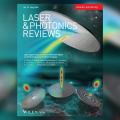Paieška
2024. 05. 16
-
G. Liaugminas, a laser scientist working on fiber optics, is a new PhD
Gustas Liaugminas, a physicist at the FTMC Department of Laser Technologies, has been awarded a PhD. He defended his thesis on "Nonlinear Pulse Formation in Optical Fibers" (academic supervisor: Dr. Kęstutis Regelskis).
Congratulations to our colleague, good luck in your future work!
Gustas hopes that his work will contribute to the development of optical fiber technologies suitable for small satellites, data protection, quantum communication and other areas of wide interest.
"The essence of my work is that when ultra-short, high-peak-power laser pulses are propagated through optical fibers, various non-linear optical phenomena are observed that can broaden the spectrum of the pulse - or convert the pulse to other wavelengths. These phenomena open up new applications and avoid some of the limitations encountered with pulsed fiber lasers.
The work consists of two parts. The first one investigated the wavelength conversion of a fiber laser into visible and near-infrared wavelengths using photonic crystal fibers specially designed for nonlinear interactions. The generation of pulses in the near-infrared is important because of the current rapid development of quantum cryptography, which is expected to be widely used in the future to protect sensitive data.
The developed scheme uses only fiber optic components and can therefore be integrated into ultra-small systems such as the CubeSat satellites.

(Defending a PhD. Photo: FTMC)
In the second part of the research, a pulse regeneration circuit was demonstrated that allows short and compressible pulses to be formed from long and uncompressible diode laser pulses, with durations of up to several hundred femtoseconds [a million billion femtoseconds could be "bridged" into a single second].
The importance of these studies lies in the fact that the initial pulses from the laser diode can be injected into the described regenerator at different repetition rates, which allows the realisation of short pulse operation with good quality and tunable repetition rate. Tunable repetition rate sources are important for pulse processing of various materials, as the repetition rate of the pulses must change with the change in the scanning speed of the laser beam," says G. Liaugminas.
The FTMC laser scientist adds that his thesis research on optical frequency conversion has led him to become more interested in quantum communication - and to continue his work in this direction. He is also pleased to have been able to demonstrate a method to stabilise the pulses of a laser diode and to observe the dynamics of its formation.
FTMC information
Susiję:

2024. 09. 12
-
R. Petkevič, who develops 3D printing technologies, becomes a PhD
He was the first in the world to combine two laser metal deposition technologies!
-f164b73b03e1ce1f823ed2886206aa9f.png)
2024. 05. 15
-
Laser for blood monitoring and the search for star clusters: young FTMC physicists have won Open Readings 2024
Engineer Aivaras Špokas and technician Erikas Cicėnas have been awarded for the best oral presentations.

2024. 05. 13
-
Lithuanian research on the cover of the prestigious journal Laser & Photonics Reviews!
FTMC physicists have theoretically calculated, fabricated and laboratory tested innovative optical lenses for terahertz imaging.

